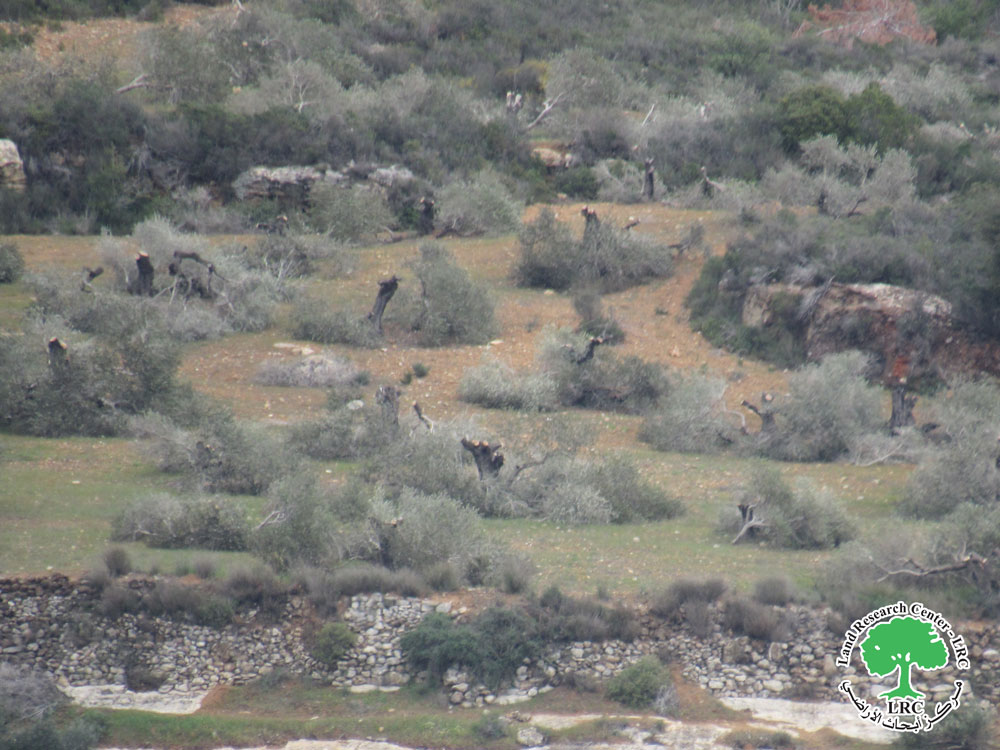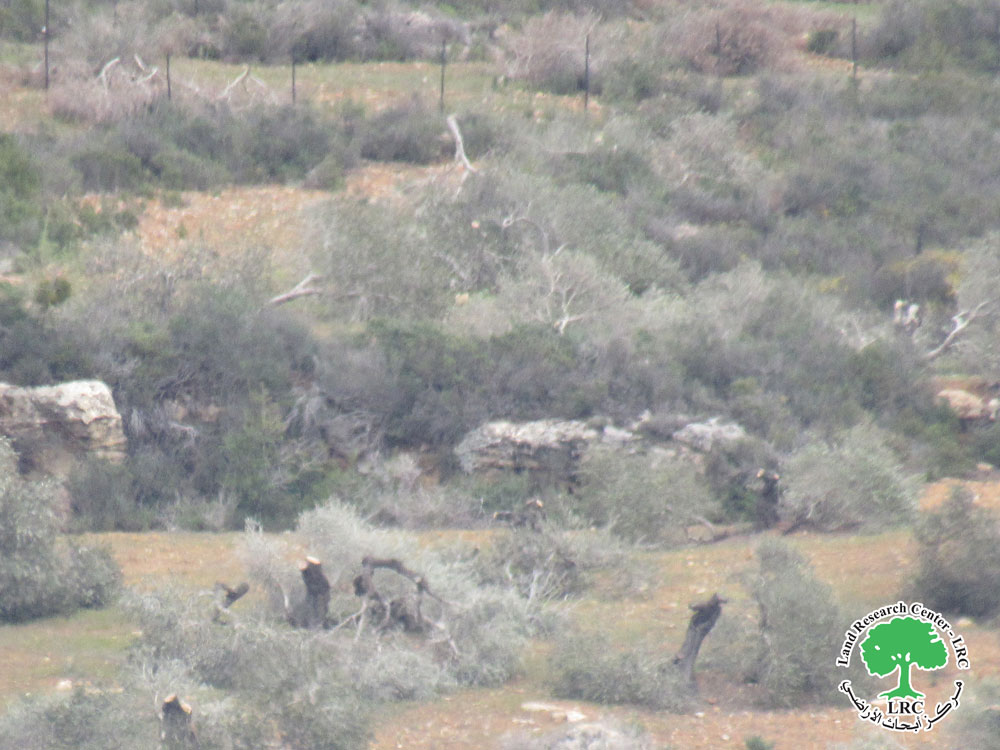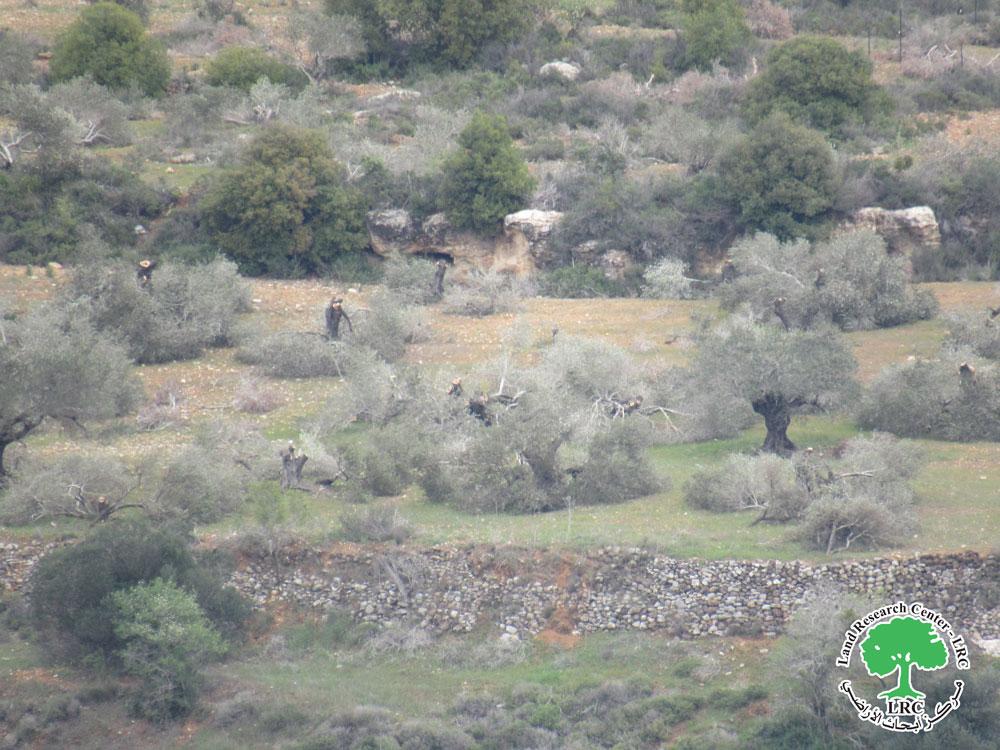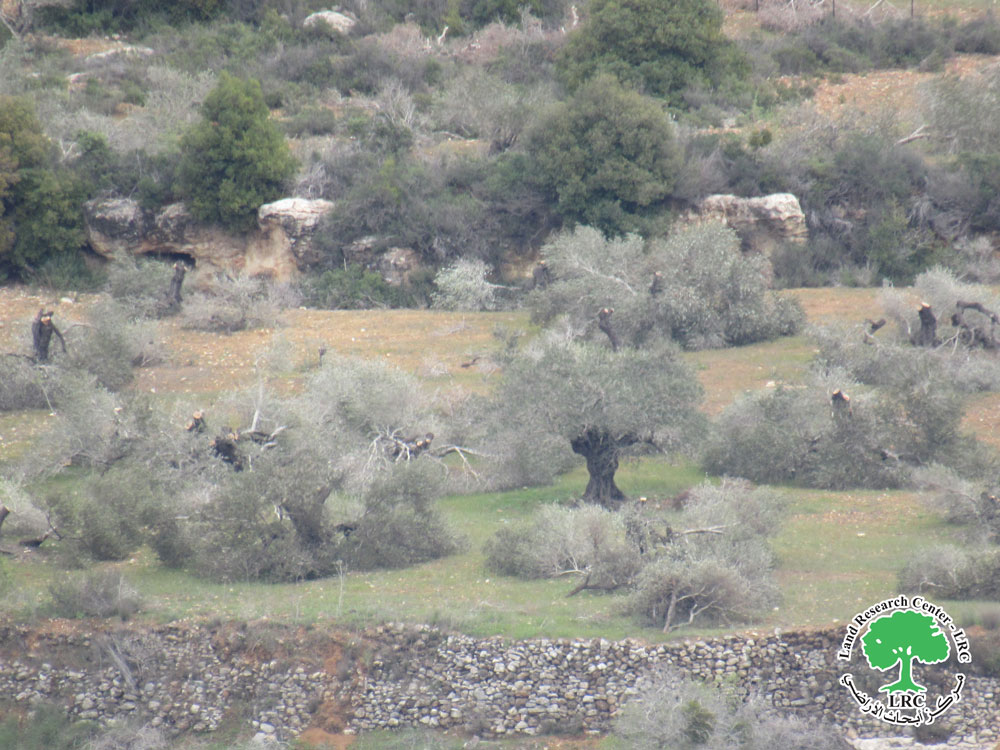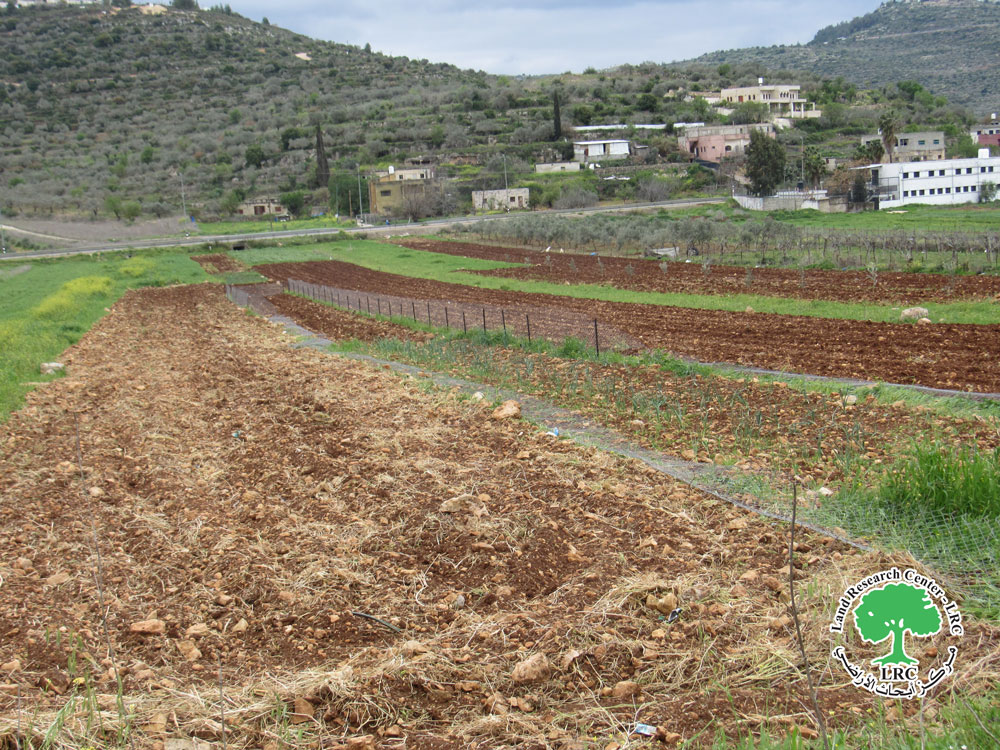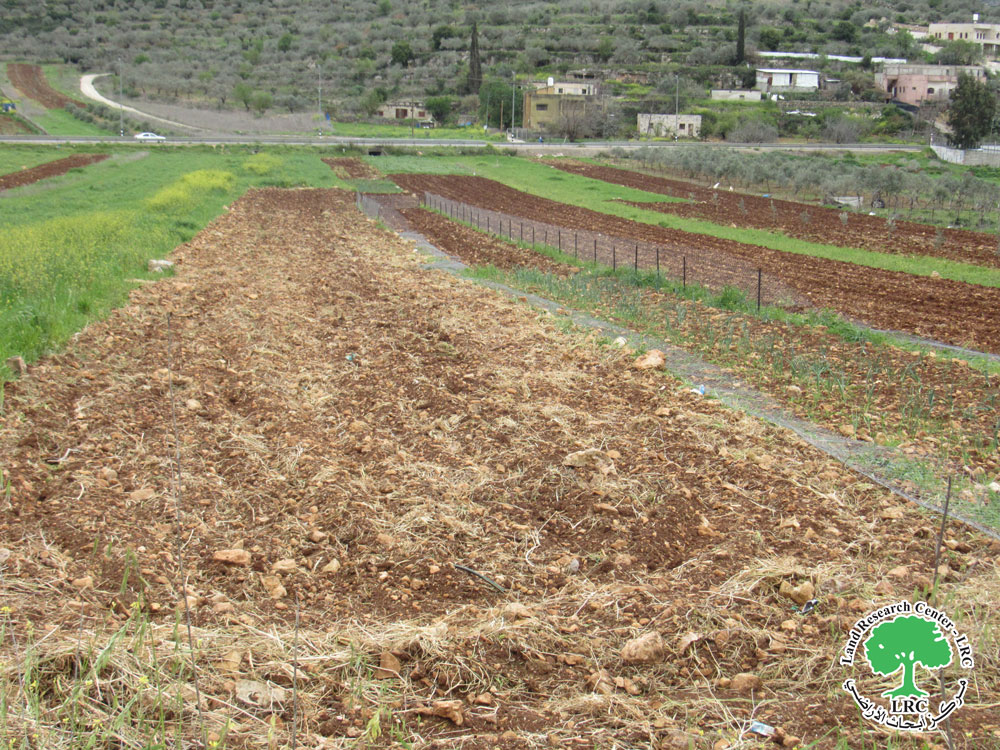مستعمرو " عيلي" يقطعون ويخربون 150 شجرة زيتون معمّرة وممتلكات زراعية في أراضي قرية الساوية / محافظة نابلس
- الانتهاك: قطع أشجار معمّرة والاعتداء على الممتلكات الزراعية وسرقة بعضها.
- الموقع: قرية الساوية / محافظة نابلس.
- تاريخ الانتهاك: 17/03/2025.
- الجهة المعتدية: مجموعة من المستعمرين من مستعمرة " عيلي".
- الجهة المتضررة: عدد من المزارعين
تفاصيل الانتهاك:
شهدت قرية الساوية الواقعة الى الجنوب من مدينة نابلس عصر يوم الاثنين الموافق (17/3/2025)م وقع اعتداء جديد من قبل مجموعة من المستعمرين من مستعمرة "عيلي" الجاثمة على أجزاء من أراضي القرية من الجهة الشرقية منها.
يشار الى أن مجموعة من المستعمرين قد استهدفوا منطقة " القليلة" و" جبل الشونة" التابع لأراضي القرية، حيث على بعد 100متر أقام الاحتلال قبل عدة أعوام بؤرة استعمارية تدعى " نفيه شوهام" التابعة لمستعمرة عيلي، حيث قام هؤلاء المستعمرون وعبر ماكنة كهربائية مخصصة لقطع الأشجار في قص وتخريب أغصان 150 شجرة زيتون معمّرة توجد في ذلك الموقع، مما أدى الى إلحاق خسائر فادحة بالمزارعين.
من جهة أخرى، فقد أقدمت مجموعة من المستعمرين في نفس الفترة على مداهمة منطقة سهل قرية الساوية، حيث قاموا باستهداف قطعتين زراعيتين عبر سرقة 160 زاوية حديدية وتخريب أسيجة معدنية كانت تحيط بتلك القطع الزراعية.
وتعود ملكية تلك الأشجار والقطع الزراعية المتضررة الى عدد من العائلات هم:
المزارع المتضرر | عدد أفراد العائلة | عدد الإناث | عدد الأطفال | مساحة الأرض المستهدفة / دونم | الضرر |
محمد داوود عبد الفتاح عبد الرازق | 6 | 3 | 2 | 4 | قطع أغصان 25 شجرة معمرة وتضررها جزئياً |
نائل عادل رجا خير الله | 3 | 2 | 0 | 5 | قطع وتخريب أ غصان 45 شجرة معمرة وتضررها جزئياً |
جميل عبد القادر محامده | 7 | 4 | 2 | 7 | تخريب وقطع 80 شجرة زيتون وتضررها بشكل جزئي |
محمد محمود سليمان جازي | 4 | 1 | 0 | 4 | سرقة 80 زاوية حديدية وتخريب سياج بطول 60مترا |
جميل أحمد محمود محامدة | 4 | 2 | 1 | 4 | سرقة 80 زاوية حديدية وتخريب سياج معدني 80متر طولي |
المجموع | 24 | 12 | 5 | 24 |
|
من جهته أفاد المزارع المتضرر محمد داوود عبد الرازق لباحث مركز أبحاث الأراضي بالتالي:
" إن الأراضي التي تم استهدافها من قبل المستعمرين - حيث في السابق وقبل الحرب على غزة - كان من السهل الوصول إليها وفلاحتها والاعتناء بالأشجار، وكانت تلك الأشجار في موسم الزيتون في السنة الماسية كانت تنتج ما لا يقل عن 15 تنكة زيت زيتون، ولكن بعد السابع من اكتوبر من العام 2023م لم نستطع دخول الأرض، إلا بعد الحصول على تنسيق مسبق في موسم الزيتون الماضي، ولعدة ساعات فقط، ولم نتمكن من جني ثمار الزيتون وكثير من الثمار بقيت على الأشجار، حيث يحاول الاحتلال فرض مبدأ التنسيق المسبق ونحن لا نستيطع الآن الدخول الى أراضينا".
وأضاف القول:
" يوم الاثنين عصراً أبلغت من عدد من المزارعين ممن يقطنون أول القرية، بأن هناك أصوات مناشير في أرضي، وفي المنطقة ككل، حيث الصوت يسمع من منطقة بعيدة كون المنطقة هي جبلية، حيث على الفور راقبنا المنطقة من بعيد ولاحظنا وجود مجموعة من المستعمرين في الأرض يقومون بقطع الأشجار، وفعلياً لا نستيطع الذهاب بسبب تواجد جيش الاحتلال، حيث أبلغنا المجلس القروي والذي بدوره أبلغ الارتباط المدني في نابلس، ولكن لا نتائج حقيقية، لقد قطع المستعمرون كافة أشجار الزيتون التي ورثتها أباً عن جد وهي بالنسبة لي بمثابة الإبن حيث أراقب نموها منذ كنت طفلا".
يشار الى انه بحسب سجلات البحث الميداني لطاقم مركز أبحاث الأراضي، فإن قرية الساوية تعتبر من أكثر القرى والبلدات التي تتعرض الى مضايقات مستمرة من قبل المستعمرين، حيث على مدار العشرين عاماً قام المستعمرون على عدة فترات بقطع أغصان الأشجار وتخريب عدد كبير من الـأراضي بالإضافة الى إغلاق مساحات شاسعة من الأراضي ومنع المزارعين دخولها مما تسبب في ذلك بخسائر كبيرة طالت القطاع الزراعي في القرية، علماً بأن معظم الأراضي التي تم استهدافها تتركز في الجهة الشرقية للقرية في محيط مستعمرة "عيلي" والبؤر الاستعمارية التابعة لها.
قرية الساوية[1]:
تقع قرية الساوية على بعد 20كم من الجهة الجنوبية من مدينة نابلس، ويحدها من الشمال قريتي يتما وياسوف ومن الغرب قرية اللبن الشرقية ومن الشرق قريتي تلفيت وقبلان ومن الجنوب قرية اللبن الشرقية ومستعمرة "عيلي" المقامة على جزء من أراضيها.
يبلغ عدد سكانها (2761) نسمة حتى عام ( 2017 ) م.
تبلغ مساحتها الإجمالية 10,733 دونم، منها 310 دونم عبارة عن مسطح بناء لقرية الجلمة.
وصادر الاحتلال من أراضيها ما مساحته (2662) دونم وفيما يلي التوضيح:
1- نهبت المستعمرات من أراضي القرية مساحة (2022) دونم ، وهي:
اسم المستعمرة | سنة التأسيس | مساحة الأراضي المصادرة / دونم | عدد المستعمرين 2018 | المساحة الكلية للمستعمرة |
عيلي | 1984 | 1543 | 4191 | 3360 |
ريخاليم – شفوت راحيل | 1991 | 479 | 812 | 547 |
2- نهبت الطريق الالتفافية رقم 60 من أراضي القرية ما مساحته ( 640) دونم.
تصنيف الأراضي حسب اتفاق أوسلو للقرية:
- مناطق مصنفة B ( 1459) دونم.
- مناطق مصنفة 9274) C) دونم.
التعقيب القانوني:
إن البيئة الفلسطينية عامةً تتعرض لانتهاكات بيئية عديدة من قبل الاحتلال الإسرائيلي، ضاربة بعرض الحائط كافة القوانين والأعراف الدولية والوطنية المتعلقة بحماية الحقوق البيئية، وإن الحق بالعيش في بيئة نظيفة وسليمة هو حق لصيق بالإنسان منذ الخليقة. ودائماً ما يحاول الاحتلال الظهور بمظهر الحريص على الشؤون الدولية البيئية على الرغم من توقيعها على اتفاقيات كبرى لحماية البيئة أبرزها اتفاقية بازل عام1989م واتفاقية روتردام عام2008م واتفاقية ستوكهولم2001م واتفاقية رامسار عام 1971م، وكذلك مواثيق جودة الهواء والمناخ ورغم ذلك تقوم بانتهاك جميع هذه المعاهدات دون محاسبة أو مراقبة.
بالإضافة إلى النصوص الخاصة بحق التمتع ببيئة نظيفة وسليمة لكل من يقع تحت الاحتلال العسكري بحسب القوانين والمواثيق والمعاهدات الدولية، كالعهد الدولي الخاص بالحقوق الاقتصادية والاجتماعية والثقافية بموجب قرار الجمعية العامة للأمم المتحدة 2200 ألف (د-21) المؤرخ في 16 كانون الأول / ديسمبر 1966 في المادة (1) البند (2): "...لجميع الشعوب، سعياً وراء أهدافها الخاصة، التصرف الحر بثرواتها ومواردها الطبيعية دونما إخلال بأية التزامات منبثقة عن مقتضيات التعاون الاقتصادي الدولي القائم على مبدأ المنفعة المتبادلة وعن القانون الدولي. ولا يجوز في أية حال حرمان أي شعب من أسباب عيشه الخاصة...".
ومما لا شك فيه أن الاعتداءات التي يقوم بها الجانب الإسرائيلي تخالف قوانين "دولة الاحتلال" قبل غيرها من القوانين، وبالرجوع إلى تفاصيل هذه الحالة نجد أن قانون العقوبات الإسرائيلي لعام 1977م وتعديلاته قد نص على أن التعدي على ممتلكات الغير لارتكاب جريمة فعل معاقب عليه بالقانون، وبقراءة المادة 452 من قانون العقوبات الإسرائيلي نجد أن القانون يخالف من يرتكب اعتداءً أو ضرراً للممتلكات سواء ( بئر ماء، بركة ماء، سد، جدار أو بوابة فيضان بركة، أو أشجار مزروعة، جسر، خزان أو صهريج ماء) يعاقب بالسجن عليه خمس سنوات.
كما أن المادة 447 من قانون العقوبات الاسرائيلي نصت على أنه:" من فعل أي من ذلك بقصد ترهيب مالك عقار أو إهانته أو مضايقته أو ارتكاب جريمة، عقوبته السجن سنتين:
(1) يدخل أو يعبر العقار؛ (2) بعد دخوله العقار بشكل قانوني، بقي هناك بشكل غير قانوني.
(ب) تُرتكب جريمة بموجب هذا القسم عندما يحمل الجاني سلاحًا ناريًا أو سلاحًا باردًا، عقوبته هي السجن أربع سنوات".
وبقراءة نص المادتين نجد بأن قانون العقوبات الإسرائيلي جرم مجرد دخول أي شخص بدون وجه حق إلى عقار ليس بعقاره بهدف الإهانة أو المضايقة أو الترهيب ويعاقب على ذلك الفعل سنتين، وتتضاعف العقوبة عندما يدخل المعتدي ويرتكب جريمة في عقار غيره باستخدام سلاح أو أداة حادة أو حتى الاعتداء على الأراضي الزراعية من قطع وحرق وتخريب، وهذا ما تم تجريمه صراحةً في نص المادة 447 من قانون العقوبات الإسرائيلي آنف الذكر، كما يعاقب 5 سنوات لمن يتسبب بضرر للممتلكات المذكورة في المادة 452 وعليه فإن المعتدي " المستعمر" يجب أن تكون مخالفته مضاعفة الأولى بالدخول لعقار ليس بعقاره والثانية بالتعدي على الأشجار المزروعة وقطعها مما تسبب بضرر بيئي.
وعليه فإن المعتدي الإسرائيلي يخالف دون أي وجه حق ما جاء في القوانين والمعاهدات الدولية، وما جاء أيضاً في قوانين "دولته" الداخلية مخالفةً صريحة، وعليه لا بد على "القضاء الإسرائيلي" محاسبة ومعاقبة المستعمرين على هذه الأفعال بموجب نصوص قوانينهم وما جاء فيها. إلا أنه لا يوجد أي مسائلة قانونية للمعتدي من قبل القضاء الإسرائيلي. ولكن هذا لا ينفي حق أي إنسان على هذه الأرض أن يعيش في بيئة نظيفة وسليمة وآمنة من أي انتهاك واعتداء ضدها.
مشروع: حماية الحقوق البيئية الفلسطينية في مناطق "ج" SPERAC IV - FCDO
Disclaimer: The views and opinions expressed in this report are those of Land Research Center and do not necessarily reflect the views or positions of the project donor; the Norwegian Refugee Council.
إخلاء المسؤولية: الآراء ووجهات النظر الواردة في هذا التقرير هي آراء ووجهات نظر مركز أبحاث الأراضي ولا تعكس بالضرورة وجهات نظر أو مواقف الجهة المانحة للمشروع؛ المجلس النرويجي. للاجئين
[1] المصدر: وحدة نظم المعلومات الجغرافية – مركز أبحاث الأراضي.
